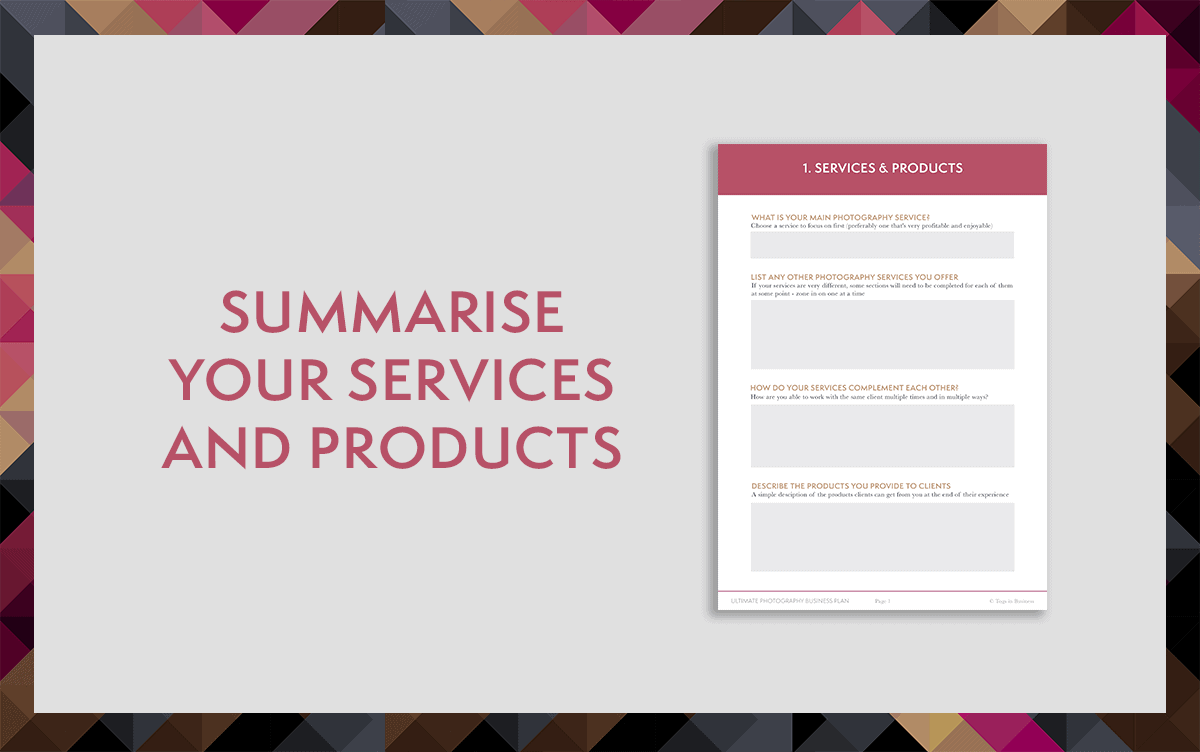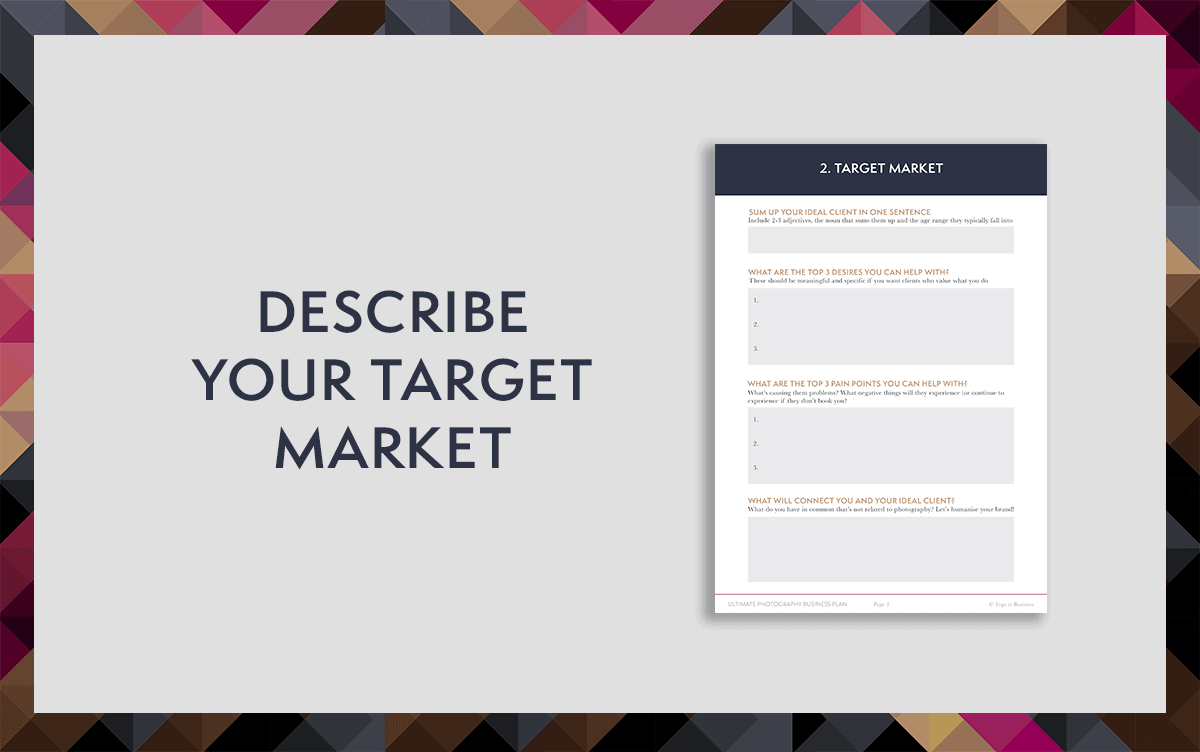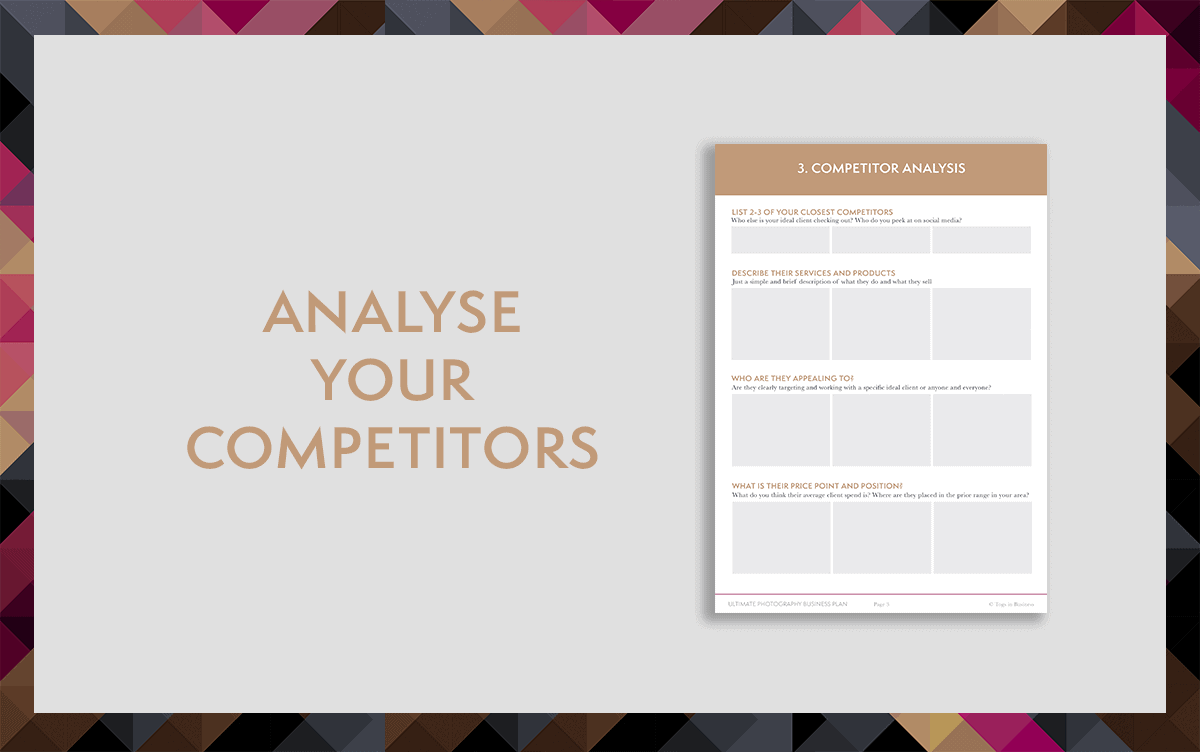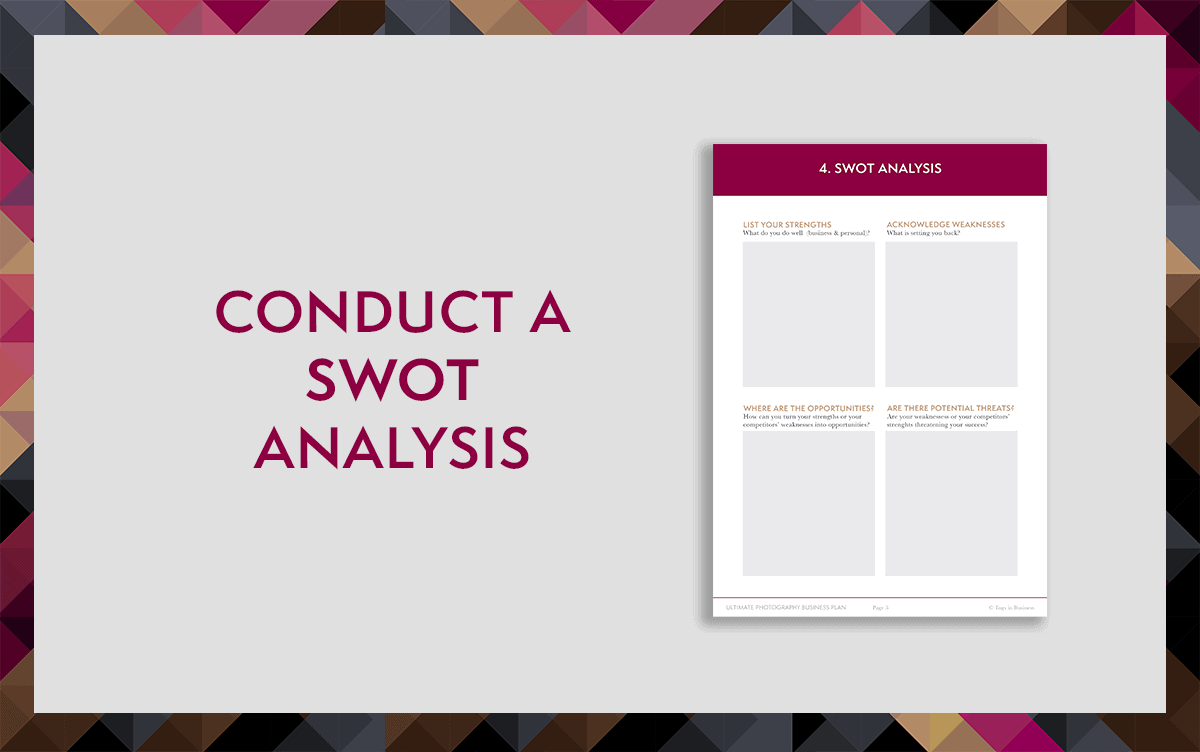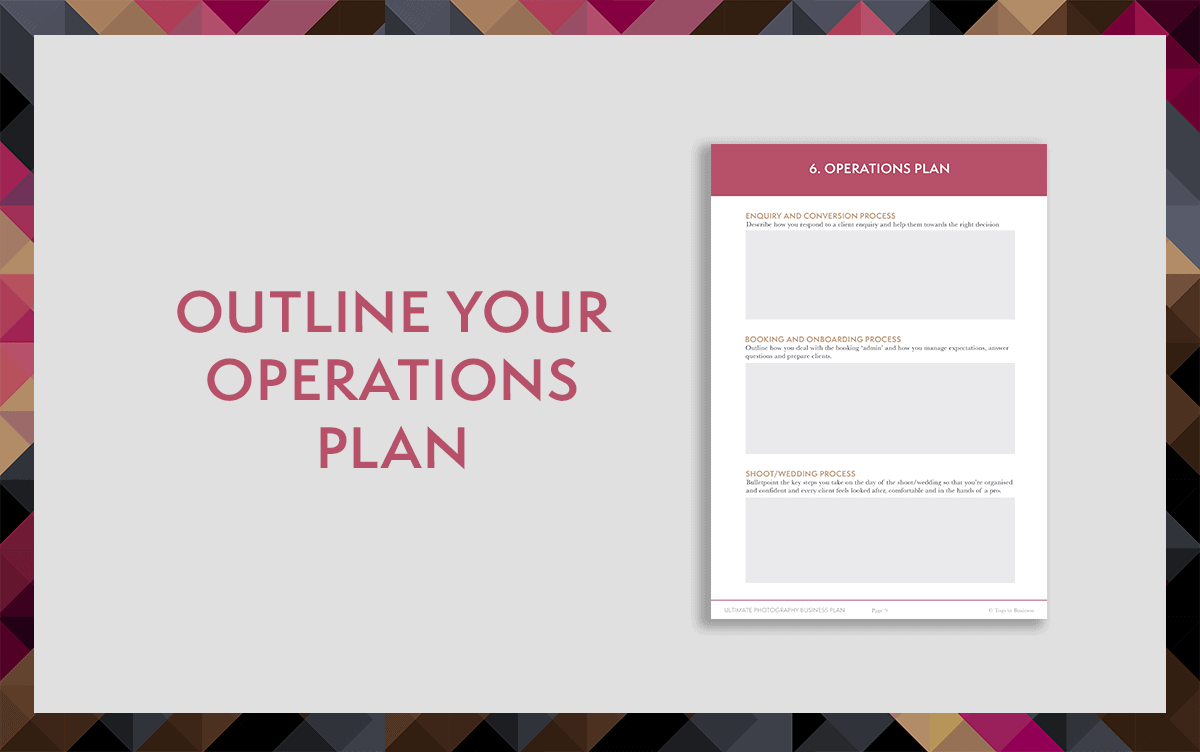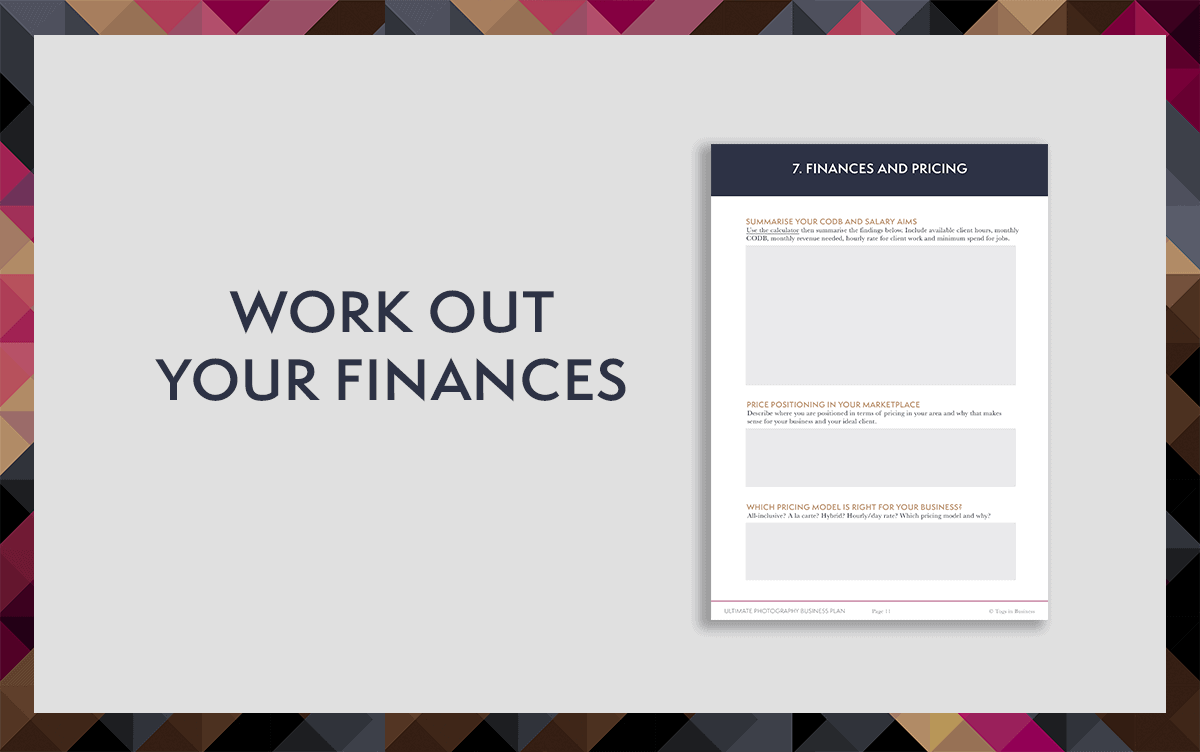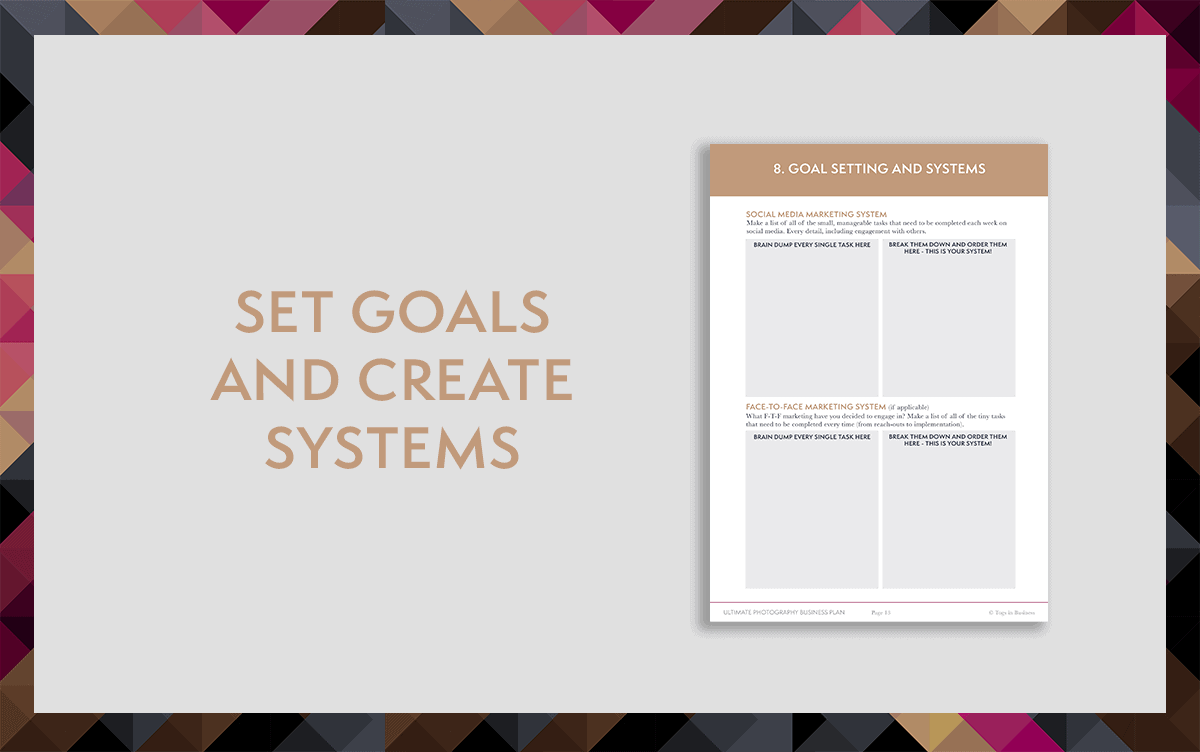5. OUTLINE YOUR MARKETING PLAN
In this section you’ll put together the brass tacks of a marketing plan for your photography business. It’s going to provide you with a focus and put an end to the overwhelm and indecision that comes from having no strategy to follow. You’ve done a lot of the work already in the previous sections so refer to it throughout.
If you want to delve even deeper into this - You should definitely check out my
Marketing Systems Workshop!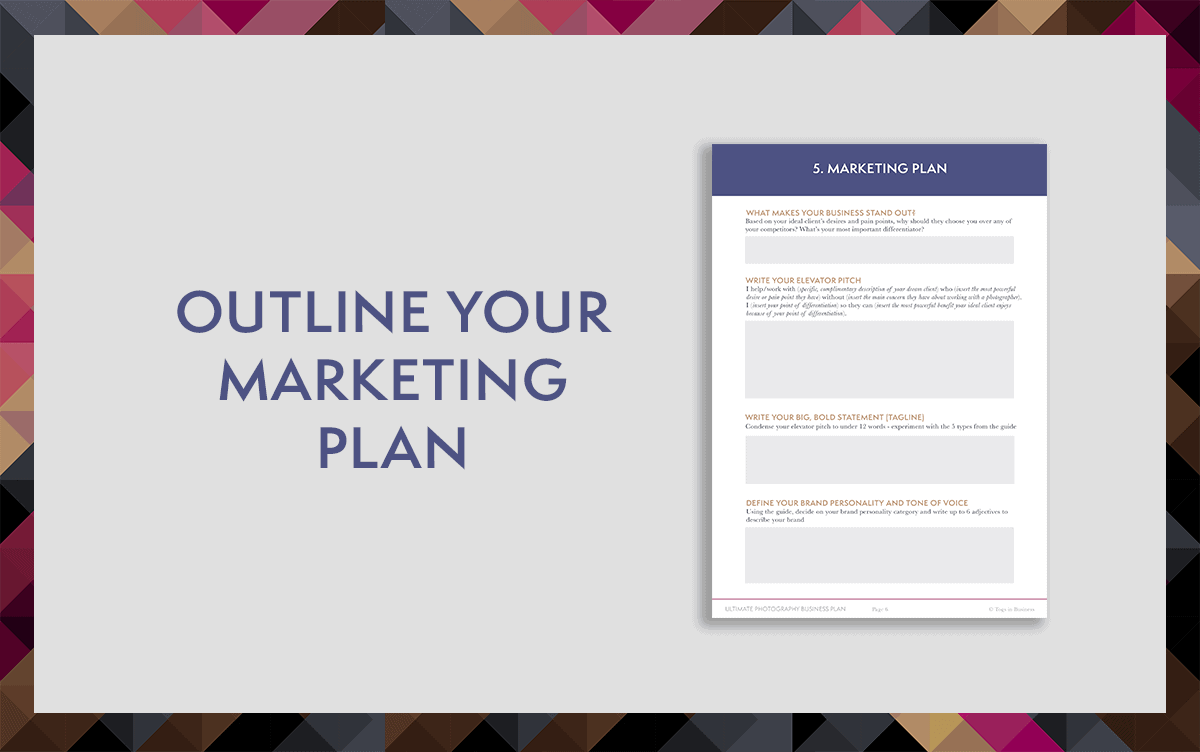
What makes your business stand out?
How and why is your business the best choice for your ideal client?
If you don’t know the answer to this question then how can you plan to win this person over in a vast sea of competition?
You might also hear this called your ‘Positioning Statement’ or 'Point of Differentiation'. It’s important that you position your photography business in the marketplace as being the best at something your ideal client cares about.
If you have a very unique style of photography in your area and it’s desirable for enough people then you have your main point of differentiation all sewn up. Lucky you!
However, not many photographers can say that these days. Let’s face it, there are lots of photographers shooting in a similar style and there’s nothing wrong with that. It just means you need to find something else to use as a differentiator and it has to matter to your ideal client. What can that be?
Here, you’re going to decide on the most important way in which you and your business are different from your main competitors. Something that will matter to the person you want to work with.
Don’t overthink it! Remember everything about this plan can change any time you want it to. Just go with your gut and get something down for now.
So what makes your photography business the best choice for this person? You’ve already done the work! Your point of differentiation should relate directly to your ideal client’s pain points and desires and also to the strengths and opportunities you described in the previous section. So check those out and go from there.
E.g. I’m the best choice for my ideal client because I combine premium personal branding photography with training on how to use it effectively.
Write your Elevator Pitch
You’re now going to craft your elevator pitch. You might sometimes hear this referred to as your 'value proposition’ or
'brand message'.
Now, it's unlikely you’re going to love your first attempt so don’t even worry about it. It will evolve and you will get to something eventually that makes your heart sing.
To make this super easy, here’s an elevator pitch formula you can use. All the work is already done in the previous sections so just fill in the gaps! This is
not prescriptive - feel free to play around with it and change the order.
I help/work with
(specific, complimentary description of your dream client) who
(insert the most powerful desire or pain point they have) without
(insert the main concern they have about working with a photographer). I
(insert your point of differentiation) so they can
(insert the most powerful benefit your ideal client enjoys because of your point of differentiation).
E.g.
I work with ambitious creative entrepreneurs who want modern images that reflect their unique brand without any awkward posing. I combine this with step-by-step training on how they can effectively use their brand photography to grow their business.Write your big, bold statement (tagline)
This is going to come from condensing down your elevator pitch and it’s likely to be the headline text on your website homepage and across your online and printed media. You might want to call it your tagline or strapline. I like ‘big, bold statement’.
Let’s keep this under 12 words. Punchy is the order of the day. I know it’s difficult to master brevity when there’s so much you want to convey but when it comes to this, you really need to decide - what’s the most important thing you want your ideal client to know? Bear in mind that subheadings can expand on your big, bold statement so don’t worry about what you’re not able to include!
Your big, bold statement will typically encapsulate your point of differentiation, your ideal client or the benefit your service brings. Sometimes 1 of these, sometimes 2 and sometimes all 3. It’s totally up to you and I’d strongly urge you to write down as many different ideals as you possibly can using those 3 elements.
Here are five types of big, bold statements you can play around with:
What you do and who you do it for
E.g. Documentary family photography for perfectly imperfect families
What you do and what they get
E.g. Crazy good brand photography that grows your business
What they get
E.g. Get ready to be happy in your own skin
What they get and what they don’t get
E.g. Heart-bursting wedding photography without leaving the party
What they don't get
E.g. Say goodbye to boring stock images forever
Need some inspiration from well-known brands?
Babbel - The shortest path to real-life conversations in a new language
Loom - Video recording, simplified
Bear - Mattresses designed to improve your sleep
ConvertKit - Audience building for creators
17Hats - Leave the chaos behind
Dropbox - Focus on the work that matters
Quickbooks - Smart, simple accounting software - with no commitment
Evernote - Your notes. Organised. Effortless.
Uber - Get there. Your day belongs to you.
Define your brand personality and tone of voice
You already outlined things that you and your ideal client have in common that can connect you to each other and establish that relatability and likability. That’s huge, but let’s build on it here and humanise your brand even further.
Your brand needs a personality and, within that, its own tone of voice. This is central to your ideal client feeling a strong connection and a huge sense of trust towards you.
Think about your favourite brands -
do they have a consistent brand personality and tone of voice? That's going to be a huge part of why you love them so much.
If you are the person behind the business then your brand personality should be closely linked to
your personality. And your brand tone of voice should be close to the way
you communicate as a person. Simple.
If you try to give your brand a wacky, extroverted personality and tone of voice when you are actually very sincere and introverted then running your business is going to feel all kinds of wrong. Not to mention, when clients meet you in person they’re going to wonder what the hell’s going on. Authenticity is so important.
Luckily, someone has done some great work to help us out here.
Jennifer Aeker is a psychologist who came up with five brand personality categories. All you need to do is decide where your business falls.
SOPHISTICATED - charming, refined, high-class, elegant, beautiful, feminine, glamorous, exclusive, polished, romantic,
EXCITING - intriguing, imaginative, modern, trendy, spirited, push limits, playful, create hype, fun, enthusiastic, edgy, sarcastic, provocative, passionate, upbeat, casual, quirky, witty, funny
SINCERE - genuine, warm, caring, down-to-earth, wholesome, honest, authentic, emotional, feel-good, trustworthy, friendly, nostalgic, respectful, cheerful, kind, soulful
RUGGED - bold, strong, adventurous, masculine, outdoorsy, powerful, free, fierce, cool, unapologetic, energetic, matter-of-fact, dry, frank
COMPETENT - professional, reliable, successful, intelligent, hard-working, secure, logical, conservative, serious, informative, formal, smart, authoritative, respectful,
Without overthinking it, is there a brand personality category (or two if you really can’t decide) that you immediately know your business should fall into? Go with your gut and make a decision.
Decide on the best adjectives from above that perfectly describe the brand personality and tone of voice your business has (or should have) and note them down. Your marketing should always be drenched in a good dose of these adjectives!
E.g.
I have a sincere brand. It’s trustworthy and friendly and communicates in a genuine and soulful way, often full of emotion.What content are you going to create?
Content marketing helps you to build trust and likability and answer your ideal client’s questions. If it’s researched and optimised for search results (SEO), it also helps you to reach fresh people who might be interested in your photography business.
Today’s clients expect high-quality, consistent content from your brand, especially if you want them to value what you do and invest.
So, what type of content does your ideal client like to consume most? And, crucially, what do you enjoy creating? This is how you decide on the right medium for you. Please don’t think that you have to be doing live-streams, recording videos and writing blog posts - choose ONE of these content opportunities and give it your all.
Now decide how often you’re going to create a piece of content for your audience. Every week, every two weeks, every month? I’d say every month is the absolute minimum and if that’s all you can commit to, don’t worry at all. 12 great pieces of content each year is more powerful than 52 mediocre pieces. If you have to choose - choose quality over quantity and
don't make the mistake of thinking every piece of content you create has to be about photography!This content should be published to your website, sent to your email list (no matter how small) and used to create several different social media posts. Repurpose it to get maximum value for minimum effort -
here's how to do that (and a free planning template!)E.g.
One video recorded every two weeks - optimised and embedded on my website, sent to my email list and used as inspiration for five Instagram postsWhich social media platform will you use and how?
Which social media platform is most suited to your ideal client and your brand? Where is this person hanging out online?
Also ask yourself, which platform will complement your content marketing most?
A clever marketer will use one piece of ‘core’ content to create lots of different and engaging social media posts. Don't make the mistake of thinking you need to be on every single one - choose ONE platform to be amazing on. Either forget the others or just maintain a presence on them with the minimum of effort. Again, quality over quantity. That way you can learn how to use the platform effectively and build an engaged audience there so you can generate leads.
So, what's your social media platform of choice? How often will you post? What will you post? How will you engage with others? What is your main objective?
And will you 'maintain a presence' on any others?
E.g.
My main social media platform is INSTAGRAM
I’ll post once a day to my grid and at least three times a day to stories
I will alternate sharing my work with personal photos, testimonials, behind the scenes videos, text-based tips, inspirational quotes and reposts
I’ll engage with other IG users for at least 15 minutes every day
My main IG objective is to drive people to my website
I’ll maintain a presence on Facebook using similar contentWill you do any face-to-face marketing?
Photographers who enjoy face-to-face interactions and use them consistently and authentically to market their services can often be booked solid from word-of-mouth alone! However,
in-person marketing doesn’t suit some personalities at all, and it’s by no means essential, so feel free to miss this out.
Is it something you would excel at? If so, describe what it should look like.
E.g.
Regularly attend local networking groups
Speak/teach at events
Nurture in-person relationships with wedding vendors
Take stands at fairs or exhibitions
Arrange in-person collaborationsWill you seek publicity for your business?
Leveraging someone else’s audience to get eyes on your photography business can be a very wise move if your ideal client is among that audience. This might mean
featuring on someone's podcast, YouTube channel or livestream, guest blogging, writing press releases, submitting wedding images to magazines/blogs etc.
Here, you’ll decide whether or not you’re going to seek media attention as part of your marketing strategy. Do you have the capacity for this and does it make sense for you and your ideal client? If not, skip this section.
E.g.
Offer myself as a guest on dog-related podcasts/radio shows/tv shows
Get a wedding featured in ‘Bespoke Brides'
Do a free shoot for an Instagram Influencer in return for specific exposureNB. You'll find that, if you nail the loyalty and referrals part (coming up soon), publicity happens by default without you having to put in any extra effort. 😉How will you generate and nurture leads?
The marketing you’ve outlined so far is all to help your ideal client to become
aware of you. That’s all. Awareness marketing is crucial, but it’s just the beginning of your ideal client’s journey with you.
In order to have a
successful photography business, you need to take those ideal clients from awareness - to the next stage. And that next stage is
not getting in touch with you to enquire about your photography services (that’s like getting married after one date!).
Did you know that the average conversion rate for a service-based business website like yours is 3%? That means that 97 our of 100 visitors leave without getting in touch!
Sobering, right?
This is because your ideal photography client will need around 11 touch points with you and your business before they’re ready to make an enquiry.
Eleven.
It’s up to you to make sure those 11 touch points happen and you do that by capturing your lead as early as possible and nurturing them with your amazingly helpful content and engaging brand personality until they’re falling over themselves to work with you.
You’re now going to decide how you plan to generate leads for your photography business and how you plan to make the right ones fall in love with your brand.
The most popular way to do this is to get your ideal client to
exchange their email address for something they want or need. You might call this an opt-in or a lead magnet. I have some here on this very page.
Once you have their email address,
you add them to an email sequence (using an email marketing system like Mailerlite, ConvertKit or Mailchimp) which serves them up with the very best of your content. Content that answers their questions, addresses their desires and concerns, tells them stories and captures their heart.
Content that sells.
So, describe how you will
generate leads for your photography business so you can then nurture the right people with your email nurture sequence.
E.g.
A free 'Brand Planning Checklist for Creative Entrepreneurs’ opt-in
Lead capture forms at exhibitions and fairs
Waiting list opt-in for headshot days
‘Full pricing’ opt in (only ’starting from’ prices on website)
‘Dog Friendly Pubs, Cafes and Restaurants Map’ opt-inHow will you create loyalty and encourage referrals?
In the services section you looked at how you can align your services so that the same person can hire you over and over again. Remember it costs five times more to win a new client than to retain an existing one!
However, there’s much more to creating fierce loyalty in your clients than that. It’s important that you run your business in way that not only makes clients want to work with you again and again, but they send their friends and family to you too.
And this doesn't just apply to past clients! You should be nurturing relationships with other business owners, influencers and anyone else you'd love to include in your network. How will you nurture loyalty to you and your brand and how will you encourage referrals?
Most loyalty and referrals come simply from how genuine, consistent and personal you are when you keep in touch with your network list.
Relationships and connection are everything when it comes to word-of-mouth and longevity of business. The sooner you make this a priority every day, the better.
I simply can't recommend
Matthew Kimberley's '5 Things' guide if you really want to knock this out of the park.
Describe the ways in which you will keep in touch with your past clients
and others on your network list.
E.g.
Engaging in an authentic way with them on social media
Personal emails Connecting them to others in your networkSending Christmas/anniversary/birthday cards
Inviting them to events
Sending them ‘past client only’ vouchers or offers All of the above will increase your referrals too but you can actively encourage this too. Outline the ways in which you will motivate your people to refer you.
E.g.
Giving them a set of refer-a-friend vouchers to hand out
Adding a referral code to their online gallery
Featuring them (with permission) in your marketing content and encouraging them to share
Thanking them personally every time they refer someone to you
Gifting them credit every time they refer someone to you 
